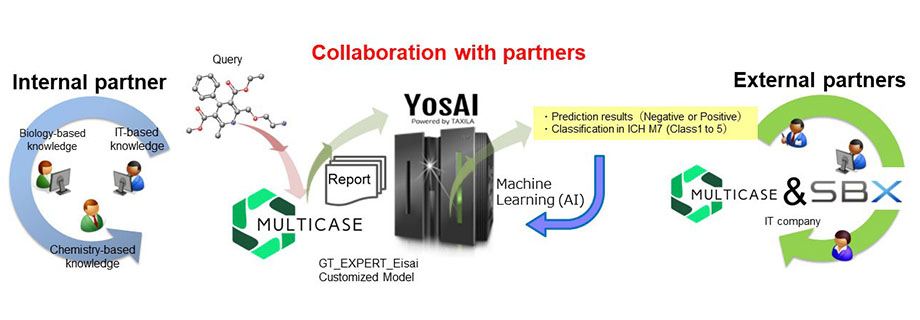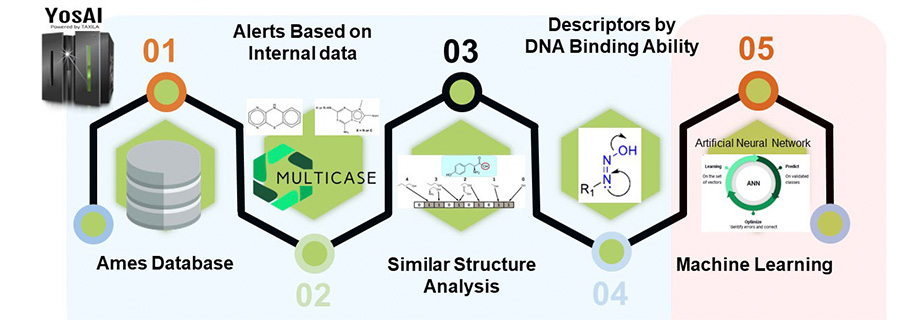Eisai is aiming to establish a novel toxicity assessment system utilizing in silico (various evaluation methods such as data analysis and simulation using computers) and AI in order to build a new technology platform for drug discovery. To accomplish this, we need to utilize our unique knowledge based on vast amounts of toxicity data and human evidence.
Developing YosAI, an AI Genotoxicity Prediction System
“YosAI” was developed as one of the technological foundations of our toxicity evaluation system. It is an AI genotoxicity prediction system which integrates commercially available in silico genotoxicity prediction software with text mining technology based on Eisai’s ideas, structural feature data, and the knowledge and know-how of genotoxicity experts.
In silico screening is effective for detecting the potential genotoxicity of candidate compounds or drug metabolites, and pharmaceutical impurities. However, the predictive performance of commercially available in silico software is limited due to the lack of data on unique chemical structures in pharmaceuticals. We have therefore developed YosAI in collaboration with IT companies SBX Corporation and MultiCASE, Inc., to 1) efficiently avoid the genotoxicity of compounds in the early drug discovery stage, and 2) evaluate the genotoxic impurities of pharmaceuticals in accordance with the International Council for Harmonization of Technical Requirements for Pharmaceuticals for Human Use (ICH) guidelines1) 2).

Features of YosAI
YosAI integrates the following unique features:
-
1.Eisai’s original database, which combines Ames test data (a type of genotoxicity test) from internal- and public-databases,
-
2.Structural alerts based on in-house data (e.g., nitrogen-containing heterocycle),
-
3.A function to search for substances of similar chemical structures,
-
4.Knowledge of the electrophilicity of chemical reactions from in-house organic synthesis chemists,
-
5.Characteristic data such as genotoxicity structural alerts and DNA binding ability.
In addition, highly accurate AI-based genotoxicity prediction is enabled by the Artificial Neural Network (machine learning). As a result, YosAI improved the prediction accuracy for Eisai compounds by around 20% compared to a commercial in silico software.

Contribution to Preclinical Projects
We are now able to analyze a few thousand compounds for lead refinement in the early phase of discovery by using YosAI, and select the candidate compounds without the risk of genotoxicity. In the development phase, hundreds of compounds, including synthetic intermediates, impurities, and degradants in multiple projects are being analyzed for in silico genotoxicity evaluation of drug impurities in pharmaceuticals as required by ICH guidelines. In the formulation development phase, genotoxicity hazard assessments are conducted for chemical substances detected as waste in dissolution tests of packaging materials. In this way, we are greatly contributing to the risk assessment of genotoxicity in each project.
We are currently working to identify compounds with unpredictable structures, making further improvements and developing next-generation YosAI system.
Starting with the development of YosAI, we will continue to build an AI Platform that incorporates various internal and external non-clinical safety data as well as biological and chemical considerations based on mechanisms of toxicity. We will work on improving the toxicity evaluation system that will provide medicines with fewer side effects to patients.
References
-
1)Nicolas K. Shinada et. al. Mutagenesis. 2022;13
-
2)Naoki Koyama and Akira Sassa et. al. Genes and Environ. 2023;45
